HOUSING TRANSITIONS FOR OLDER AUSTRALIANS
Australia's population is ageing, influenced by general trends of increasing life expectancy and declining fertility. In the 2006 Census, there were 2.6 million people (or 13% of the population) aged 65 years and over living in Australia. By the 2011 Census, this had grown to over 3 million people (or 14% of the population). This trend is expected to continue with those people aged over 65 years projected to make up 19% of Australia's population by 20311.
As people age, they experience changes in their levels of physical and economic independence. This may lead to changes in their living arrangements and social accommodation needs. Using longitudinal Census data, this article looks at the journeys of older Australians who were aged 65 years and older in 2006, exploring their housing transitions between the 2006 and 2011 Censuses.
The Australian Census Longitudinal Dataset (ACLD) is a 5% random sample from the 2006 Census which has been linked to corresponding records from the 2011 Census. Whilst Census data allows us to observe the changes across a cohort of older Australians, for example an increasing proportion of this group living in flats or units rather than separate houses, it provides little ability to directly understand the sub-group that were in separate houses in 2006 and were then in a flat or unit in 2011. This article aims to demonstrate the power of longitudinal Census data by examining the characteristics of older Australians in the housing market, including those who have moved or downsized, their household characteristics, and the types of dwellings and locations they preferred.
The point-in-time data presented in this article is sourced from either the 2006 or 2011 Census. The estimates of transitions between 2006 and 2011 are sourced from the ACLD. The ACLD was weighted so that linked records represent the population that was in scope of both the 2006 and 2011 Censuses. The ACLD has some limitations, including that the population excludes people overseas for either the 2006 or 2011 Censuses and people who died between the 2006 Census and 2011 Census (a more significant issue when analysing older Australians than some other cohorts). The ACLD also only represents two time points that are five years apart and thus does not reflect multiple changes that may occur within that time period. All longitudinal analysis in this article excludes people who were not enumerated at their place of usual residence in either 2006 or 2011 as the ACLD dwelling related data refers to the dwelling a person was counted in on Census night.
CHARACTERISTICS OF OLDER MOVERS
The housing choices of older Australians have an effect on the housing market in a number of ways. These effects include decisions to move houses to downsize, move location or move into dwellings specifically designed for older Australians such as nursing homes. However, according to the longitudinal Census data, older Australians were less than half as likely to have moved between 2006 and 2011 (16%) compared to the average for all other adults (38% of people aged 18 to 64). The proportion of older Australians who have moved is likely influenced by the high proportion who own their home outright. Typically people who own their home outright move less often than renters or those owning a home with a mortgage.
The graph below shows the characteristics of older people who moved between 2006 and 2011.
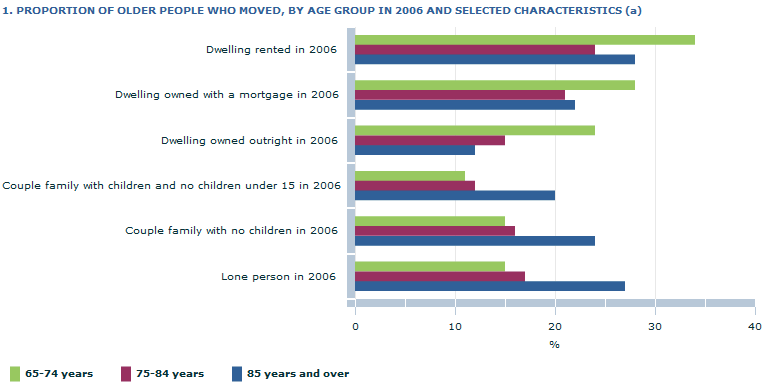
Footnote: (a) Excludes 'Not stated'.
Source: Microdata: Australian Census Longitudinal Dataset (cat. no. 2080.0)
Around 34% of people who were renting in 2006, and who were over the age of 85, moved between 2006 and 2011. This compares to 24% of renters aged between 75 and 84 years, and 28% of those aged between 65 and 74 years in 2006. Irrespective of sex, dwelling tenure, family composition or whether located in the capital city or not, those aged over 85 years in 2006 (over 90 years in 2011) were the most likely age group to have changed address between the 2006 and 2011 Census. This may be related to reasons such as ill health and moves from private dwellings to dwellings that include a level of care (e.g. nursing homes).
Older Australians who were living alone in 2006 were more likely to move than those living in couple relationships, while couple families living with their adult children were the least likely to move. Older Australians living outside of capital cities were more likely to have moved than those living in capital cities.
ARE OLDER AUSTRALIANS DOWNSIZING?
Key aspects of understanding the type of dwellings older Australians may require in the future include dwelling sizes, occupancy levels and whether older Australians downsize when they move house. Applying the Canadian National Occupancy Standard (CNOS) to the 2011 Census data found that 85% of older Australians (over 65 years) who lived in private dwellings had one or more spare bedrooms, which may be due to older people remaining in family homes following the departure of children.
Out of the older Australians who moved between 2006 and 2011, two out of every five (41%) moved to a dwelling with fewer bedrooms (excludes those not living in private dwellings or living in private dwelling with more than four bedrooms). Around three quarters of this group (76%) moved to a dwelling with exactly one less bedroom.
The graph below shows the changes in the types of dwellings occupied by Australians aged 65 years and over (in 2006) who downsized. Whilst the majority (85%) of downsizers lived in a separate house in 2006, more than half (60%) lived in a flat, unit, apartment, semi-detached, terrace or town house by 2011.
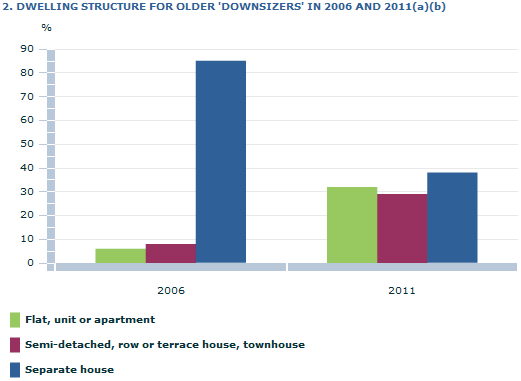
Footnote: (a) 'Other dwellings' are included in the total. (b) Excludes 'Not stated'.
Source: Microdata: Australian Census Longitudinal Dataset (cat. no. 2080.0)
Whilst moving home may occur due to a wide range of life events, around 16% of downsizers had transitioned from a one family household in 2006 to a lone person household in 2011. This suggests that their move could be associated with an event such as family separation or being widowed.
HOUSING FOR THOSE THAT NEED ASSISTANCE
One of the anticipated planning challenges arising from an increase in the number of older Australians is the increased number of people requiring care and assistance with core activities (self-care, mobility and/or communication). This has implications for the number of care facilities, such as nursing homes and the support services that may be required to care for people with higher needs. We know from the longitudinal Census data that the median age of older people who had moved from a private dwelling to selected non-private dwellings (nursing homes or other cared accommodation for the aged) between 2006 and 2011 was 86 years in 2011.
Around 250,000 older Australians living in private dwellings in 2006, reported a need for assistance with core activities in 2011 but not in 2006, and a quarter of this group moved between 2006 and 2011 (25%), a higher rate than for other older Australians. Of the 25% that reported a need for assistance in 2011 but not in 2006 and moved, around 33,000 moved to another private dwelling, whilst 29,000 moved into a selected non-private dwelling.
In total, 54,000 older Australians moved into a selected non-private dwelling between 2006 and 2011. This includes people whose reported need for assistance did not change or was not stated. Women made up around 70% of movers into selected non-private dwellings.
The following graph shows the proportion of older people that moved from a private dwelling to a selected non-private dwelling between 2006 and 2011 and their reported need for assistance with core activities.
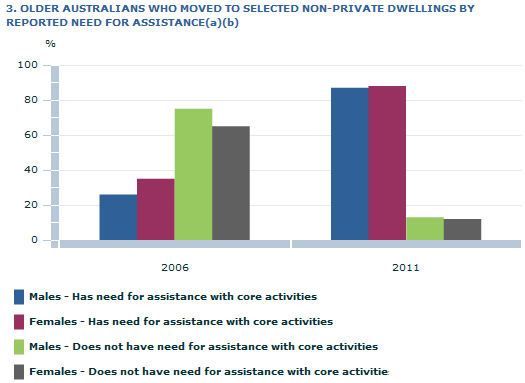
Footnote: (a) Excludes 'Not stated'. (b) Selected non-private dwellings are nursing homes or other cared accommodation for the aged (not self-contained).
Source: Microdata: Australian Census Longitudinal Dataset (cat. no. 2080.0)
Of those older Australians who moved from a private dwelling into a selected non-private dwelling between 2006 and 2011, a much higher proportion reported a need for assistance with core activities in 2011 (87% of men and 88% of women) than they did in 2006 (26% of men and 35% of women), with over half (58%) of those that moved into a selected non-private dwelling having a reported core need for assistance in 2011 only.
SEA-CHANGE MOVES
In order to assist with planning adequate housing for older Australians, it is important to identify where older Australians have moved to. This is of particular importance to councils in regional areas that are seen as popular destinations for so called sea-change moves. These moves are characterised by people relocating permanently from major urban centres to a regional coastal destination for a change of lifestyle and have been linked with those leaving the workforce and entering retirement2. Increased numbers of older Australians moving into an area is likely to increase demand for services, such as health care and home care. For this analysis, the population group has been extended to people aged 55 years and over to allow us to capture those whose move could be associated with retirement and to allow for more detailed analysis of specific regions.
As an example of the potential impact of older sea-changers, this analysis considered people aged 55 years and over in 2006 who subsequently moved to selected coastal local government areas (LGAs) of Queensland (see map below). Of all the people who lived in the selected coastal LGAs in 2011 and had moved between 2006 and 2011, around 22,000 (44%) were sea change movers who had moved into the area from elsewhere, while around 27,000 (56%) moved within the area. Of the 22,000 movers who relocated to these areas from other locations in Australia, the bulk were moving from LGAs in or surrounding the major cities of Brisbane and the Gold Coast (6,200) or the state of NSW (6,100).
SELECTED COAST LOCAL GOVERNMENT AREAS OF QUEENSLAND
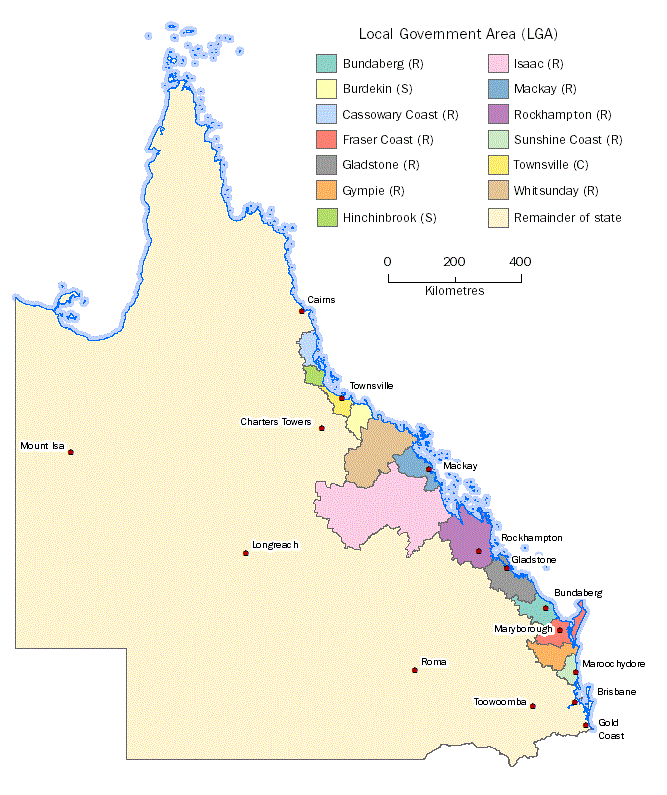
The graph below shows the number of older Australian's who moved to selected 'sea change' areas of the Queensland coast and their place of origin.
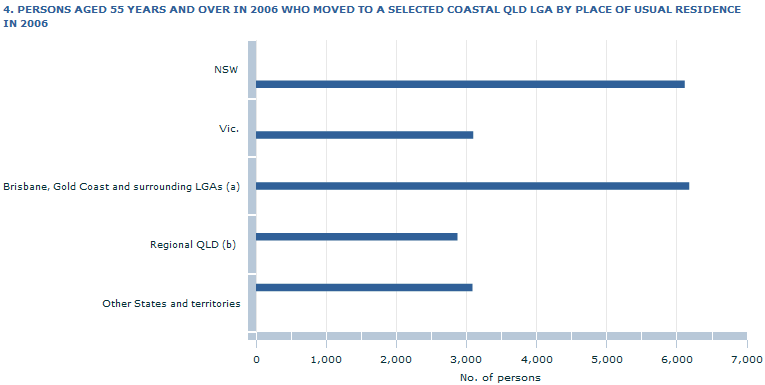
Footnote: (a) Includes LGAs of Brisbane, Gold Coast, Ipswich, Morton Bay, Redland and Logan. (b) Includes all other LGAs in Queensland outside of Brisbane, Gold Coast, Ipswich, Morton Bay, Redland and Logan and the selected coastal local government areas.
Source: Microdata: Australian Census Longitudinal Dataset (cat. no. 2080.0)
Around 70% of the sea-changers moved into separate houses. Almost half of these people moved into a separate house with 3 bedrooms. The sea-change moves were generally made by those in the younger end of the age range, with those between 55 to 64 in 2006 making up over 14,000 (or 67%) of the 22,000 movers.
Sea change moves are often associated with changes in people's employment circumstances, for example following retirement. Amongst the 14,000 55-64 year old movers to selected coastal LGAs in QLD, 37% were employed in 2006 but were not in the labour force in 2011. This was higher than when compared to all 55-64 year olds in Australia, where 19% were employed in 2006 but were not in the labour force in 2011.
FURTHER INFORMATION
This article has explored a few examples of the types of analysis that are possible using linked Census data to explore the housing transitions of older Australians between 2006 and 2011.
The ACLD is now available in ABS TableBuilder, from Microdata: Australian Census Longitudinal Dataset (ABS cat. no. 2080.0). ABS TableBuilder allows users to build their own customised tables to undertake further analysis and research. Future waves of data will enrich this dataset further, enabling detailed exploration of the complex journeys and pathways of Australian lives.
FOOTNOTES
1Data available in the ABS publication, Population Projections, Australia, 2012 (base) to 2101 (cat. no. 3222.0). Quoted projections refer to Series B data.
2 ABS 2004a "Seachange - New Coastal Residents" in Australian Social Trends, 2004 (cat. No. 4102.0).
DEFINITIONS
Canadian National Occupancy Standard - The Canadian National Occupancy Standard for housing appropriateness is sensitive to both household size and composition. The measure assesses the bedroom requirements of a household by specifying that:
- there should be no more than two people per bedroom
- children less than 5 years of age of different sexes may reasonably share a bedroom
- children 5 years of age or older of opposite sex should have separate bedrooms
- children less than 18 years of age and of the same sex may reasonably share a bedroom, and
- single household members 18 years or over should have a separate bedroom, as should parents or couples.
Households living in dwellings where this standard cannot be met are considered to be overcrowded.
Capital City - Refers to Greater Capital City Statistical Areas as defined in the Australian Statistical Geography Standard (ASGS), 2011.
Downsizers - For the purposes of this article, downsizers are people who lived in a private dwelling with 4 bedrooms or less in both 2006 and 2011 who had at least 1 less bedroom in 2011 than they did in 2006. This definition excludes people who lived in a dwelling in the '5 bedrooms or more' categories in either 2006 or 2011 as the exact number of bedrooms in the dwelling is not known.
Not in the labour force - People not in the labour force are those people who, during the week prior to Census Night, were neither employed nor unemployed. They include people who were keeping house (unpaid), retired, voluntarily inactive, permanently unable to work, in gaol, trainee teachers, members of contemplative religious orders, and people whose only activity during the week prior to Census Night was jury service or unpaid voluntary work for a charitable organisation.
Need for Assistance with Core Activities - Measures the number of people who need assistance with the core activities of self-care, mobility and/or communication because of a disability or long term health condition lasting six months or more, or old age. This population is conceptually similar with the population of people with a profound or severe disability as collected in the Survey of Disability, Ageing and Carers (SDAC).
Private Landlord - Where the household pays rent to a real estate agent or other person not in the same household.
Retirement Village - Dwelling location containing accommodation for retired and aged people who care for themselves.
Selected Non-private Dwellings - A non-private dwelling is a dwelling or establishment that provides a communal or transitory type of accommodation or care. For the purposes of this article, in scope selected non-private dwellings were restricted to usual residents of nursing homes or other cared accommodation for the aged (not self-contained). Other non-private dwellings such as hotels, hostels, prisons, religious and charitable institutions, boarding schools, defence establishments and hospitals were excluded. Residents of self-contained dwellings in retirement villages are counted as residents of private dwellings.
Tenure - The nature of a unit's (i.e. household's, income unit's or person's) legal right to occupy the dwelling they usually reside in. Tenure is determined according to whether the unit owns the dwelling outright, owns the dwelling but has a mortgage or secured loan against it, is paying rent to live in the dwelling or has some other arrangement to occupy the dwelling.
 Print Page
Print Page
 Print All
Print All
 Quality Declaration
Quality Declaration